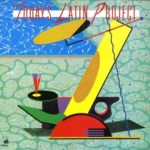
A leftfield reimagining of vaunted Afro-Cuban jazz classics, in a new school “futuristic” Japanese Pop style, shouldn’t sound so interesting as it does in Today’s Latin Project. Launched on the demise of one famous group (The Tokyo Cuban Boys) and the rise of one important, new musical voice, Yasuaki Shimizu, you’d expect something titled Today’s Latin Project to be something more than a tossed off record label creation.
A love letter of sorts to tropical music, it tends to get slagged off as half a good album. As huge a name as Yasuaki’s is (or later became) to attach to such a project, I marvel that both sides of the equation came to bat in various, creative ways.
For Yasuaki, this made up group allowed him to further explore the world music influences he had began to roll in circa Kakashi and うたかたの日々. In due time, two years later, as Yasuaki Shimizu and the Saxophonettes he’d dive fully into latin music on the aptly titled Latin. The “Afro” side would actually come later in 1989’s Aduna.
For performers Kazuo Ohtani, Michio Nagaoka, and Kazuaki Misago (to name a few), who were responsible for a large part of Japan’s fascination with tropical music, they were able to show an evolution to their sound. Working in the ’60s and ’70s under the tutelage of Tadaaki Misago, as the Tokyo Cuban Boys, they’d introduce the sounds of Latin America with various vastly popular interpretations and originals of easy listening standards. Now as arrangers and main players of Today’s Latin Project they were able to capture both the old and the new with equal aplomb.
On their side, on songs by masters like Ernesto Lecuona, Nilo Menéndez and Rafael Hernández (whose “El Cumbachero” never fails to liven up any party) get introduced to the modernist, electro-tinged sonics of mid ’80s Japan.
Horns sound just as warm as any ’70s TCB production, but Kazuo Ohtani and Michio Uehara come particularly inspired, transforming songs you may have heard before like the above, or “Jungle Drums” (an early exotica heavy, that Edu Lobo also took a brilliant crack at), and “Siboney” (the moody one) into “wavier”, heavier, jazz funk grooves.
This might the one album, or one of many, your older parent might appreciate equally as you. “Siboney” never sounded as sparkly, fusion-y and as strident as you’ll heard it here, before. Nearly all instrumental, it’s not entirely out of your jurisdiction to take this album out to the pool or have it soundtrack a truly chill BBQ hang. Nilo’s “Aquellos Ojos Verdes” gains an entirely new life as a blazing groove, far from its troubadour beginnings.

Yasuaki takes the same gifted Latin Japanese jazz session musicians (and adds the help of sister, Mieko Shimizu) to go deeper into the “Afro” side of the Afro-Cuban equation and uses all sorts of production to create a knottier, futuristic take on Exotica.
A deep cut by Armando Orefiche, “Hindu”, features Yasuaki’s stunning electro-acoustic percussion and brass arrangements, beefing up the original with spacier dub-style effects. “Danza Lucumi” by now an Afro-Cuban jazz standard by Ernesto Lecuona, gets the Mariah-treatment as Yasuaki (with Mieko’s breathy vocals) slide in the echo-treated environment and his sax hints at the more ambient side he would explore further elsewhere.
The album ends on one classic, Gonzalo Roig’s utterly romantic ballad “Quiereme Mucho” redone as a slinky, almost Ethiopique-esque, take with Yasuaki once again contributing the main brunt of the action, now using his bass clarinet to eke out even more seduction from Nobuo Kawatoh’s trumpet accompaniment. Favorite bit: when the “golden oldies” section drops out to reveal the wild electro-jungle percussion underneath.
The capper is an original, “Pygmy Land”, foretells the fourth world work Yasuaki would explore in future releases. Here deep Afro-Pop styled, swirling arrangements open up to very free Latin jazz stylings that come at you in all sorts of bite-size forms, and floating synth pads that hint at more Teutonic ideas. And thus ends a wonderful trip into the Cuban world with all its roots in Africa and the fascinating sprawl beyond it.
